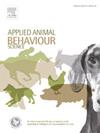Prenatal administration of lipophilic macrocyclic lactone anthelmintics can alter neonatal lamb behavioural development
IF 2.2
2区 农林科学
Q1 AGRICULTURE, DAIRY & ANIMAL SCIENCE
引用次数: 0
Abstract
The treatment of pregnant ewes with persistent macrocyclic lactone (ML) anthelmintic products is common in some countries, with the intent of alleviating the potential negative impacts of gastrointestinal nematode parasites on production, health and welfare. However, some MLs such as moxidectin, are lipophilic compounds that can cross the placenta, and many are secreted into colostrum and milk, yet the effect of MLs on neonatal lamb behaviour remains unknown. The objective of this study was to evaluate the effect of prenatal administration of persistent ML anthelmintics on the behaviour of ewes and their new-born lambs. Sixty mixed-age pregnant twin-bearing ewes were randomly allocated to one of three groups (n = 20/group): 1) administered a subcutaneous injection containing moxidectin 2–3 weeks prior to lambing (MOX), 2) administered one controlled-release capsule containing abamectin and albendazole 2–3 weeks prior to lambing (CRC), and 3) a control group that was not treated or handled other than routine care (CON). The ewes were housed indoors 4 weeks before parturition was expected to commence and remained in the same pens (n = 2 ewes / treatment) until 1 week after lambing. Behaviour of the ewes and lambs was monitored continuously using security cameras positioned above each pen. Ewe and lamb behaviour was evaluated for 3 h after parturition. Ewe grooming of the lamb, and lamb head shaking, standing, udder seeking and suckling behaviour was assessed using Cox Proportional hazard models. There was no evidence that abamectin (and albendazole) affected ewe or lamb behaviour (P > 0.10). Neonatal lambs from ewes administered moxidectin tended to be slower to shake their heads after parturition (hazard ratio: 0.65; P = 0.08), and were slower to attempt to stand (hazard ratio: 0.61; P = 0.05) compared with lambs from control ewes. These are the first known data to indicate changes in neonatal lamb behaviour associated with anthelmintic treatment of their dam. Further research is required to validate these findings and understand whether the delayed neonatal lamb behavioural development associated with moxidectin has implications for lamb vigour or survivability.
求助全文
约1分钟内获得全文
求助全文
来源期刊

Applied Animal Behaviour Science
农林科学-行为科学
CiteScore
4.40
自引率
21.70%
发文量
191
审稿时长
18.1 weeks
期刊介绍:
This journal publishes relevant information on the behaviour of domesticated and utilized animals.
Topics covered include:
-Behaviour of farm, zoo and laboratory animals in relation to animal management and welfare
-Behaviour of companion animals in relation to behavioural problems, for example, in relation to the training of dogs for different purposes, in relation to behavioural problems
-Studies of the behaviour of wild animals when these studies are relevant from an applied perspective, for example in relation to wildlife management, pest management or nature conservation
-Methodological studies within relevant fields
The principal subjects are farm, companion and laboratory animals, including, of course, poultry. The journal also deals with the following animal subjects:
-Those involved in any farming system, e.g. deer, rabbits and fur-bearing animals
-Those in ANY form of confinement, e.g. zoos, safari parks and other forms of display
-Feral animals, and any animal species which impinge on farming operations, e.g. as causes of loss or damage
-Species used for hunting, recreation etc. may also be considered as acceptable subjects in some instances
-Laboratory animals, if the material relates to their behavioural requirements
 求助内容:
求助内容: 应助结果提醒方式:
应助结果提醒方式:


